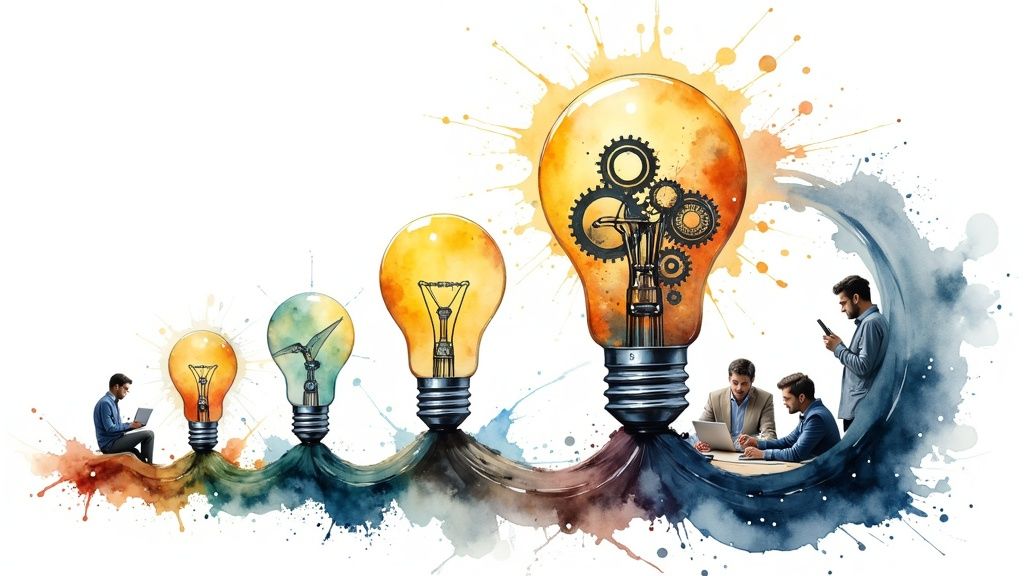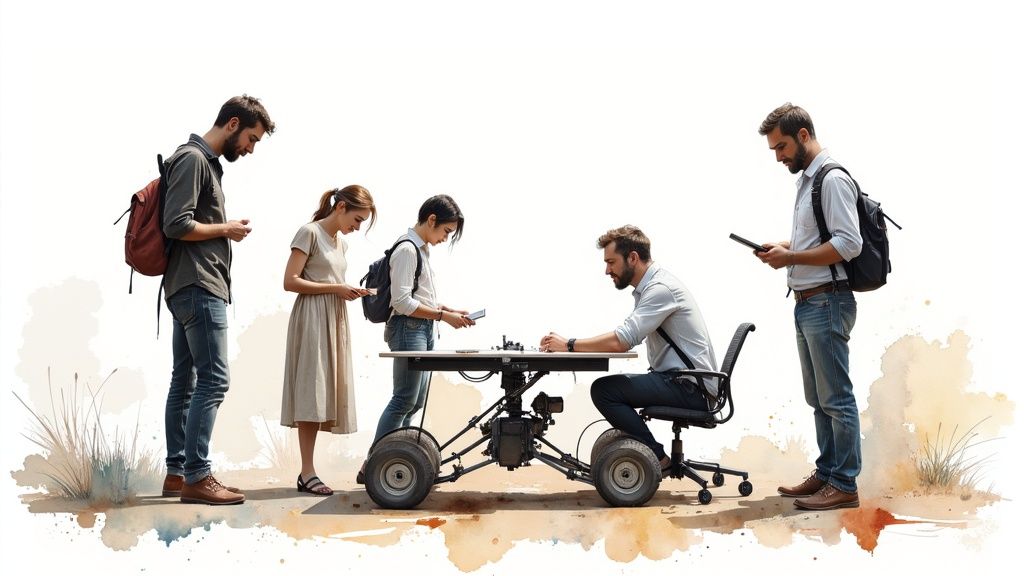
The 5 Key Stages of Innovation: From Breakthrough Ideas to Market Success
The Modern Innovation Journey

Innovation is rarely a straightforward path from idea to success. It is a complex process that combines creative thinking with structured development. To succeed, teams must embrace both the art and science of bringing new ideas to life.
The Non-Linear Nature of Innovation
Real innovation rarely follows a predictable route. Teams must be prepared for setbacks, changes in direction, and unexpected discoveries along the way. For instance, the development of the steam engine involved decades of work and multiple inventors building upon each other's progress. Just as explorers adapt their route based on the terrain, innovation teams need flexibility to respond to new insights and challenges.
Finding the Sweet Spot Between Creativity and Process
The most effective innovation happens when teams strike the right balance between free-thinking and structured development. This means creating space for brainstorming and experimentation while having clear frameworks to keep projects on track. Communication is especially critical during research and development, where technical hurdles often emerge without warning. Teams need both the freedom to explore new ideas and the discipline to turn those ideas into reality.
Essential Elements for Success
Several key factors help guide teams through the ups and downs of innovation. First, always keep the end user's needs at the center of development decisions. Understanding customer pain points helps prioritize features and ensures the final product provides real value. This customer focus brings clarity to tough decisions about what to include or cut.
Second, make testing and refinement a core part of the process. Build prototypes, challenge assumptions, and actively seek feedback throughout development. Leading companies use Agile methods to quickly incorporate user input and adapt to changing market demands. This iterative approach helps avoid wasting time on features that don't resonate with customers.
Dealing with Risk and Uncertainty
Innovation inherently involves stepping into the unknown. However, teams can manage this uncertainty through thoughtful planning and risk assessment. Having backup plans ready helps navigate inevitable challenges. More importantly, building a culture that accepts calculated risks empowers people to pursue promising but unproven ideas.
Finally, celebrate learning from both successes and setbacks. Each experience provides valuable insights that make the team stronger. When people feel safe to experiment and learn, they push boundaries and unlock new possibilities. This creates positive momentum that carries teams through the innovation journey. With the right mindset and approach, uncertainty becomes an opportunity for discovery rather than a barrier to progress.
Stage 1: Strategic Ideation and Discovery

The first stage of innovation requires much more than just coming up with random ideas. It demands a systematic approach to exploring opportunities and identifying breakthroughs. Success comes from understanding both unmet market needs and emerging technologies that could address them.
Identifying Unmet Market Needs
Great innovation starts with deeply understanding customer problems. Take the rise of Uber and Lyft as an example. Before these companies emerged, getting a taxi was often unpredictable and frustrating. By recognizing this widespread pain point, they created a more reliable transportation solution that transformed the industry. This highlights how important it is to look beyond surface-level observations and truly grasp what challenges customers face daily.
Recognizing Technological Possibilities
While customer needs point to what problems need solving, technology provides the means to solve them. For example, ride-sharing apps only became possible once mobile technology matured enough to support GPS tracking, digital payments, and instant messaging. Companies need to stay informed about new technological developments and understand how these advances could enable novel solutions. This means creating a workplace culture where teams actively learn about and experiment with emerging technologies.
Evaluating Potential Innovations
After identifying promising ideas, companies must carefully assess both market and technical factors. Market analysis looks at potential demand and competitive landscape. Technical evaluation examines whether the innovation is feasible with current technology and reasonable resources. For instance, an exciting product concept might face too much competition to be profitable. Or a technically ambitious innovation might require unrealistic development costs, even with strong market demand.
Structuring the Ideation Process
Leading organizations make innovation systematic rather than leaving it to chance. Many establish dedicated innovation teams and use methods like design thinking to solve problems creatively. This structured approach ensures ideas align with company goals and helps prioritize where to focus resources. Just as important is fostering an environment where employees feel safe sharing ideas and taking smart risks. This means encouraging open discussion, treating failures as learning opportunities, and celebrating progress at each stage. When teams feel supported in exploring new possibilities, promising innovations are more likely to emerge and thrive.
Stage 2: Focused Research and Development
Once promising ideas have been identified, the real work begins – transforming concepts into concrete solutions through careful research and development. This critical stage requires finding the right balance between ambitious exploration and practical realities while making the most of available resources. A systematic R&D process helps validate initial assumptions and ensures innovations truly meet user needs.
Balancing Exploration and Practical Constraints
Like an architect who must balance creative vision with structural requirements, innovation teams need to find the sweet spot between pushing boundaries and working within real-world limitations. While maintaining an open and exploratory mindset is essential, teams must also consider constraints like budgets, timelines, and technical feasibility. This often means making tough choices about which research paths to pursue and which to set aside for later, even when they show potential.
Resource Allocation and Momentum
Smart resource management can make or break an R&D project. Teams need to strategically allocate funding, talent, and time – especially when facing technical hurdles, which are nearly impossible to avoid entirely. For example, unexpected technical challenges can quickly drain resources if not handled proactively. Maintaining forward progress requires teams to stay flexible, communicate clearly, and be willing to shift priorities when needed.
Prototyping and Testing Methodologies
At its core, R&D centers on building and testing prototypes. This hands-on process lets teams bring ideas to life, validate assumptions, gather user input, and refine their solutions based on real data. Teams can choose from various prototyping approaches, from simple concept models to fully functional versions. The key is selecting methods that match both the type of innovation and its current development phase. Thorough testing is critical for spotting potential issues early, before major resources are committed.
Key Indicators of Readiness
Deciding when to move beyond R&D requires careful evaluation. Key signs of readiness include: proven technical feasibility, clear user benefits, strong market potential, and a viable production plan. These indicators confirm that an innovation addresses real needs and has strong market prospects. Without proper assessment, teams risk investing heavily in products that lack demand or fall short of expectations. Taking time to thoroughly evaluate readiness increases the odds of success in later development stages.
Stage 3: Strategic Design and Engineering

The third stage of innovation focuses on transforming research and development into concrete solutions through strategic design and engineering. This critical phase connects initial ideas to tangible products that solve real problems. Success requires careful balance between ambitious goals and practical constraints.
Bridging the Gap Between Concept and Reality
Creating a working solution is like constructing a complex building – it requires both vision and careful attention to real-world limitations. Design and engineering teams must find practical ways to implement ambitious concepts while working within technical constraints. For example, when mobile phones were first developed, the challenge was making them truly portable despite bulky batteries and limited networks. Engineers had to develop creative solutions to overcome these fundamental obstacles.
Design Thinking in Action
Good design starts by deeply understanding user needs and experiences. The design thinking process guides teams through stages of research, ideation, prototyping and testing to create solutions that work well and feel natural to use. This approach helps engineers see beyond technical specifications to understand how people will actually interact with and feel about the product. As a result, the final design better serves its intended purpose.
Navigating Engineering Challenges
The engineering phase involves carefully working through technical hurdles to build a functioning solution. Teams often face difficult trade-offs – for instance, making a laptop lighter might require more expensive materials. Success comes from breaking complex problems into manageable pieces, rigorous testing at each step, and clear communication across the team to quickly address issues as they arise.
Maintaining Design Integrity
Throughout development, teams must stay focused on the core vision while adapting to technical realities. Electric cars provide a clear example – early models struggled with limited range, but advances in battery technology eventually enabled practical electric vehicles that still delivered on the promise of sustainable transportation. This flexibility in implementation while maintaining key principles is essential for successful innovation.
Design and Engineering Frameworks
Teams can draw on established frameworks to manage this complex process. Agile methodologies support rapid iteration based on continuous feedback. Lean Design principles help eliminate waste and increase efficiency. The right framework depends on project specifics and organizational culture, but having a structured approach helps align design and engineering efforts with strategic goals.
This detailed focus during design and engineering creates solutions that work well and meet user needs. The next critical step is thorough testing and validation to refine the product before launch, ensuring it will succeed in real-world use.
Stage 4: Rigorous Testing and Validation
After completing the design and engineering work, thorough testing and validation becomes essential. This stage determines whether the new product or service works as intended and meets actual market needs. The focus goes beyond just finding technical issues – it's about making sure the innovation is truly ready for successful launch by identifying potential problems early and gathering vital feedback for improvements.
Systematic Approaches to Testing
A well-planned testing process uses multiple methods to examine every aspect of the innovation. Teams typically start with internal alpha testing before moving to beta testing with selected external users. For software, this means checking the user experience and interface design. Physical products undergo stress testing under different conditions. Having diverse testing approaches helps spot issues that may not show up in controlled settings.
Gathering Meaningful Feedback and Refinement
Testing is as much about collecting user input as it is about finding technical flaws. By carefully observing how testers use the product, analyzing usage data, and conducting targeted surveys, teams gain valuable insights into the user experience. For example, watching beta testers interact with a new product often reveals unexpected usage patterns that highlight needed interface or functionality improvements. This continuous feedback loop enables teams to make informed refinements.
Real-World Examples of Validation Processes
Leading companies take a methodical approach to validation. For instance, Google regularly uses A/B testing during beta phases to compare different feature versions and see which ones users prefer. Their teams collect concrete data to guide decisions about which design elements and functions to include. This systematic validation approach helps explain why Google's product launches tend to resonate well with users.
Risk Assessment and Mitigation
Testing also plays a critical role in identifying and addressing potential problems before launch. Teams assess both the likelihood and impact of various issues, from technical failures to negative user reactions. Much like how engineers test bridges with heavy loads, innovations need thorough examination for weak points. Medical devices, for example, go through extensive clinical trials to verify both safety and effectiveness.
Measuring Innovation Readiness
Determining if an innovation is ready for market requires clear evaluation criteria specific to the industry and product type. Key metrics often include technical performance benchmarks, user satisfaction scores, and market analysis findings. A consumer product might be deemed ready when it achieves set targets for positive reviews and pre-orders. This data-based assessment provides solid ground for decisions about launch timing and marketing approach. By taking this careful testing and validation approach, teams reduce risks and maximize the potential for market success.
Stage 5: Market Launch and Scaling Success

The journey from development to real-world application reaches its peak during the market launch phase. This final stage puts all the previous preparation work to the test, as companies aim to introduce their product to the world. The decisions and execution during this critical period can make the difference between a product's success or failure in the marketplace.
Building Initial Market Presence
Creating buzz and attracting early adopters requires a well-planned product launch strategy. Companies need to carefully time their marketing efforts and build anticipation through targeted campaigns. For example, Tesla mastered this approach with their product reveals and pre-order system, which helped them secure a substantial customer base before their vehicles were available. A strong initial presence sets the foundation for future growth and market expansion.
Strategies for Effective Scaling
After gaining initial traction, companies face the challenge of growing their operations while maintaining quality. This growth phase often tests an organization's ability to handle increased production demands and distribution complexities. Success requires developing solid processes that can support rapid expansion without compromising core product values. Like a growing tree needs deeper roots, scaling businesses must build stronger operational foundations.
Managing Growth While Maintaining Innovation Integrity
Growth brings both opportunities and risks. Companies must balance increased production with ongoing product refinement and improvement. This balance is essential since rushing growth at the expense of quality can harm long-term success. The scaling phase also provides valuable real-world data from users, which smart companies use to guide future improvements and keep their products relevant.
Frameworks for Market Penetration and Expansion
Companies can rely on proven frameworks to guide their growth strategies. The Ansoff Matrix outlines four key approaches: market penetration, market development, product development, and diversification. This tool helps businesses choose the right growth path based on their current market position. The Product Life Cycle model provides another useful lens, helping companies adjust their strategies as products move through different market stages.
Handling the Challenges of Scaling
Scaling brings diverse challenges that require careful management. Companies must efficiently allocate resources, maintain reliable supply chains, and provide consistent customer support. Quality control becomes especially important during rapid growth. This might mean investing in new production facilities, hiring skilled workers, or implementing more rigorous quality assurance processes.
Real-World Examples and Lessons from Setbacks
Learning from both successes and failures helps companies scale more effectively. Amazon demonstrates how to adapt operations and infrastructure to support massive growth. However, even successful companies encounter obstacles. These challenges often provide important lessons – like the need for better market research or clearer marketing messages – that help shape future growth strategies.
Ready to transform your vague business ideas into secure investment opportunities and significantly reduce innovation risk? Discover how Derisky.ai can enhance your innovation performance by implementing actionable metrics and enabling data-driven decisions. Visit https://derisky.ai to learn more.







